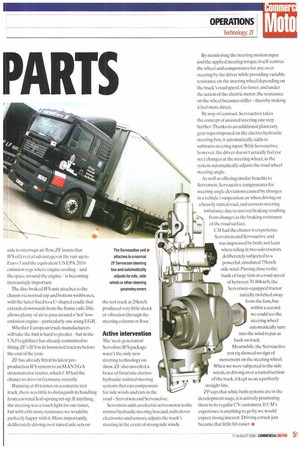SUM OF THE PARTS
Page 58

Page 59

If you've noticed an error in this article please click here to report it so we can fix it.
German automotive component supplier ZF recently gave a sneak preview of its exhibits for the upcoming Hanover Show. Brian Weatheriey is impressed by some new (and not so new) suspension and steering technology.
Wise men say there is nothing so powerful as an idea whose time has come.They have clearly been waiting to say this about independent front suspension (IFS) for heavy trucks, so far without much success.
There's nothing new about IFS on heavy commercial vehicles— PSV manufacturers embraced it years ago, not least in integral and semi-integral bodied buses and coaches. But with a few notable exceptions (such as Dennis with its fire engines), European truck makers have shown little interest in using IFS on production models because of the higher cost and relative complexity compared to a straight-beam front axle.
However, that resistance could be about to change. At a recent technology seminar, ZF unveiled the latest incarnation of its LGV IFS system. What is new is the use of ZF/ Sachs combined air-spring and damper modules and, more significantly, the next generation Servoline heavy truck rack-andpinion steering system, jointly developed by ZF and Bosch.
Parallel world
Described by ZF's engineers as a 'parallel' unit, the mechanical/hydraulic steering box features an operating cylinder that sits alongside the rack-and-pinion unit, but works independently of it.The upshot is that the overall width of the steering control unit is significantly reduced, making packaging a lot easier and allowing for greater cut angles.
Other IFS benefits include a higher roll stiffness — the spring centres are effectively wider than the leaf springs on a conventional beam axle. ZF says that compared like for like with a conventional beam axle equipped with air bags, the latestgeneration IFS (which has an axle load capacity of 6.5-8.0 tonnes) incurs no weight penalty. However, against a leaf-sprung beam axle it is still not there yet.
The real clincher in terms of persuading the truck makers to fit IFS is its 'packaging appeal'. With no front axle to interrupt air flow, ZF insists that IFS offers real advantages in the run-up to Euro-5 and the equivalent US EPA 2010 emission rcgs where engine cooling—and the space around the engine—is becoming increasingly important.
The disc-braked IFS unit attaches to the chassis via normal top and bottom wishbones, with the latter fixed to a U-shaped cradle that extends downwards from the frame rails.This allows plenty of air to pass around a 'hot' lowemission engine— particularly one using EGR.
Whether European truck manufacturers will take the hint is hard to predict—but in the US,Freightliner has already committed to fitting ZF's IFS in its bonneted tractors before the end of the year.
ZF has already fitted its latest preproduction IFS system to an MAN TGA demonstrator tractor, which CM had the chance to drive in Germany recently.
Running at 40 tonnes on a concrete test track, there was little to distinguish its handling from a normal leaf-sprung set-up. If anything, the steering was a touch light for our tastes, but with a bit more resistance we would be perfectly happy with it. More importantly, deliberately driving over raised axle sets on the test track at 20km/h produced very little shock or vibration through the steering column or floor.
Active intervention
'the 'next-generation' Servoline/IFS package wasn't the only new steering technology on show. ZF also unveiled a brace of futuristic electrohydraulic assisted steering systems that can compensate for side winds and ruts in the road— Servotwin and Servoactive.
Servotwin adds an electric servo motor to the normal hydraulic steering box and, with clever electronics and sensors, adjusts the truck's steering in the event of strong side winds. By monitoring the steering motion input and the applied steering torque, it self-centres the wheel and compensates for any oversteering by the driver while providing variable resistance on the steering wheel depending on the truck's road speed. Go faster, and under the action of the electric motor, the resistance on the wheel becomes stiffer—thereby making it feel more direct.
By way of contrast, Servoactive takes the concept of assisted steering one step further.Thanks to an additional planetary gear superimposed on the electro-hydraulic steering box, it automatically adds or subtracts steering input. With Servoactive, however, the driver doesn't actually feel (or see) changes at the steering wheel, as the system automatically adjusts the road wheel steering angle.
As well as offering similar benefits to Servotwin, Servoactive compensates for steering-angle deviations caused by changes in a vehicle's suspension, or when driving on a heavily rutted road, and corrects steering imbalance due to uneven braking resulting from changes in the braking resistance of the road surface.
"Th
CM had the chance to experience Servotwin and Servoactive and was impressed by both, not least when riding in two solo tractors deliberately subjected to a powerful, simulated 75km/h side wind. Passing close to the bank of large fans at a road speed of between 70-80km/h, the Servotwin-equipped tractor initially twitched away from the fans, but within a second we could see the steering wheel automatically turn into the wind to put us back on track.
Meanwhile, the Servoactive test rig showed no sign of movement on the steering wheel. When we were subjected to the side winds, or driving over a rutted section of the track, it kept us on a perfectly straight line.
ZF says that while both systems are in the development stage, it is actively promoting them to its regular CV customers. If CM's experience is anything to go by, we would expect strong interest. Driving a truck just became that little bit easier. •










































































































































































































